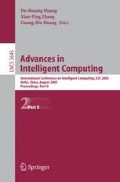Abstract
The objective of this work is to develop an optimization methodology to design adaptive truss structures with multiple optimally placed active members. The finite element model of truss structures with piezoelectric members is presented. The performance function is built for optimal design of active members at discrete locations in the output feedback control system by using the method proposed by K. Xu et al. Genetic algorithm (GA) is used to search the optimal locations of active members for vibration suppression of adaptive truss structure. A numerical example of the planar truss structure with two piezoelectric active members is performed, and the corresponding experimental set-up is designed for active vibration control. The experimental results demonstrate the effectiveness of optimal placement of active members for adaptive truss structures using genetic algorithm.
Access this chapter
Tax calculation will be finalised at checkout
Purchases are for personal use only
Preview
Unable to display preview. Download preview PDF.
References
Bland, S.M., Sheng, L.Z., Kapania, R.K.: Design of Complex Adaptive Structures Using the Genetic Algorithm. In: Proc. SPIE Int. Soc. Opt. Eng., vol. 4512, pp. 212–218 (2001)
Abdullah, M.M., Richardson, A., Hanif, J.: Placement of Sensors/Actuators on Civil Structures Using Genetic Algorithms. Earthquake Engineering and Structural Dynamics 8, 1167–1184 (2001)
Liu, F.Q., Zhang, L.M., Link, M.: Optimal Placement of Actuators and Sensors for Vibration Active Control. In: Proc. Int. Modal Analysis Conf., vol. 2, pp. 1820–1825 (1999)
Onoda, J., Hanawa, Y.: Actuator Placement Optimization by Genetic and Improved Simulated Annealing Algorithms. AIAA Journal 6, 1167–1169 (1993)
Chen, G.S., Bruno, R.J., Salama, M.: Optimal Placement of Active/Passive Members in Truss Structures Using Simulated Annealing. AIAA J. 8, 1327–1334 (1991)
Guo, H.Y., Zhang, L., Zhou, J.X., Jiang, J.: Optimal Placement of Actuators in Actively Controlled Structures by Genetic Algorithms. Process in Safety Science and Technology 3, 62–67 (2002)
Xu, B., Jiang, J.S.: Integrated Optimization of Structure and Control for Piezoelectric Intelligent Trusses with Uncertain Placement of Actuators and Sensors. Computational Mechanics 5, 406–412 (2004)
Gao, W., Chen, J.J., Ma, H.B., et al.: Optimal Placement of Active Bars in Active Vibration Control for Piezoelectric Intelligent Truss Structures with Random Parameters. Computers and Structures 1, 53–60 (2003)
Chen, G.S., Lurie, B.J., Wada, B.K.: Experimental Studies of Adaptive Structures for Precision Performance. AIAA Paper No. 89-1327-CP (1989)
Sun, C.T., Wang, R.T.: Enhancement of Frequency and Damping in Large Space Structures with Extendible Members. AIAA J. 12, 2269–2271 (1991)
Xu, K., Warnitchai, P., Igusa, T.: Optimal Locations and Gains of Sensors and Actuators for Feedback Control. AIAA paper 93-1660, 3137–3145 (1993)
Abdullah, M.M.: Optimal Location and Gains of Feedback Controllers at Discrete Locations. AIAA J. 11, 2109–2116 (1998)
Levine, W.S., Athans, M.: On the Determination of the Optimal Constant Output Feedback Gains for Linear Multivariable Systems. IEEE Trans. Automat. Contr. 1, 44–48 (1970)
Sepulveda, A.E., Jin, I.M., Schmit, L.A.J.: Optimal Placement of Active Elements in Control Augmented Structural Synthesis. AIAA Journal 10, 1906–1915 (1993)
Tsahalis, D.T., Katsikas, S.K., Manolas, D.A.: A Genetic Algorithm for Optimal Positioning of Actuators in Active Noise Control: Results form the ASANCA Project. Aircraft Engineering and Aerospace Technology 3, 252–257 (2000)
Author information
Authors and Affiliations
Editor information
Editors and Affiliations
Rights and permissions
Copyright information
© 2005 Springer-Verlag Berlin Heidelberg
About this paper
Cite this paper
Yan, S., Zheng, K., Zhao, Q., Zhang, L. (2005). Optimal Placement of Active Members for Truss Structure Using Genetic Algorithm. In: Huang, DS., Zhang, XP., Huang, GB. (eds) Advances in Intelligent Computing. ICIC 2005. Lecture Notes in Computer Science, vol 3645. Springer, Berlin, Heidelberg. https://doi.org/10.1007/11538356_40
Download citation
DOI: https://doi.org/10.1007/11538356_40
Publisher Name: Springer, Berlin, Heidelberg
Print ISBN: 978-3-540-28227-3
Online ISBN: 978-3-540-31907-8
eBook Packages: Computer ScienceComputer Science (R0)

